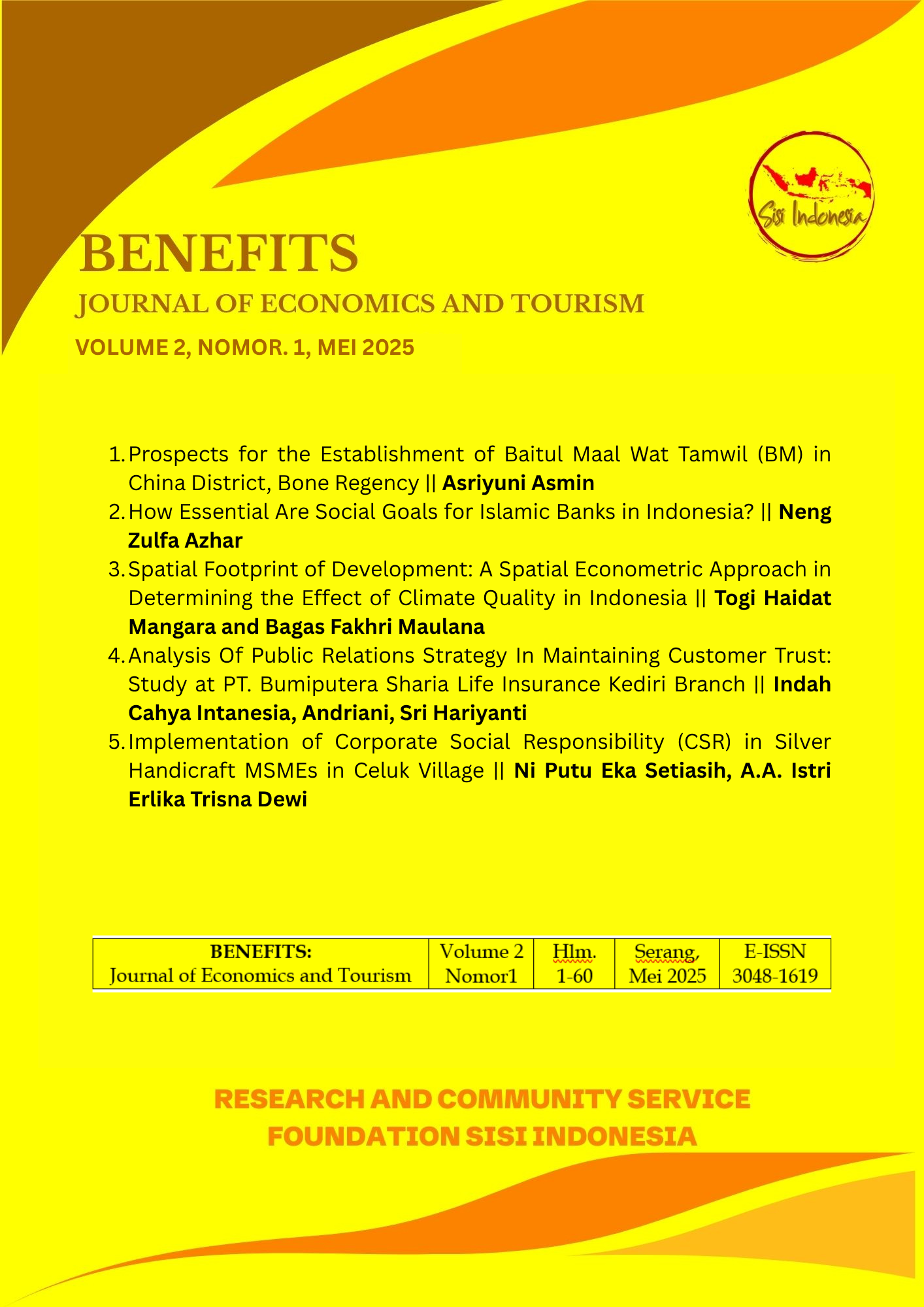Spatial Footprint of Development: A Spatial Econometric Approach to Determining the Influence of Climate Quality in Indonesia
Main Article Content
Abstract
This study aims to identify the socio-economic and infrastructure effects on environmental quality across 34 provinces of Indonesia from 2019 – 2023. The analysis is conducted by using panel data and a Fixed Effects Model to analyze how population density, industrial activity, education level, sanitation access, road length, and electricity coverage influence the Environmental Quality Index (IKLH). The results show that education has a strong positive effect on environmental quality, highligting the essence of human capital in promoting sustainability. Sanitation, electricity, and road length also show moderate associations. However, population density and industrial share do not have any significant effect on environmental quality. A Moran’s I test on the residuals indicates no significant spatial autocorrelation, suggesting limited spatial dependence in environmental quality outcomes at the provincial level. The study emphasizes the need for investments in education and basic infrastructure to support environmental improvements, while also acknowledging limitations related to spatial resolution and model specification.
Article Details
References
A’yun, I. Q., & Tiyaningsih, S. (2023). The impact of economic development and density population on environmental quality in Indonesia The impact of economic development and density population on environmental quality in Indonesia. https://doi.org/10.1088/1755-1315/1151/1/012013
Adrian, F., & Khoirunurrofik, K. (2021). The Relationship of Education and Regional Income Level on Environmental Quality: Empirical Evidence from High Populated Country. Jurnal Wilayah Dan Lingkungan, 9(2), 186–197. https://doi.org/10.14710/jwl.9.2.186-197
Han, P., Kimura, F., & Sandu, S. (2019). Household-level Analysis of Electricity Consumption on Welfare and Environment in Cambodia : Empirical Evidence and Policy Corresponding author : Han Phoumin , Ph . D Affiliation : Economic Research Institute for ASEAN and East Asia ( ERIA ). Economic Modelling. https://doi.org/10.1016/j.econmod.2019.11.025
Iryanto, A. A., Firmansyah, Y. W., Widyantoro, W., & Zolanda, A. (2022). Spatial Patterns of Environmental Sanitation Factors as Determinants of Toddlers’ Diarrhea in Pauh District, Padang City in 2021. JURNAL KESEHATAN LINGKUNGAN, 14(2), 71–81. https://doi.org/10.20473/jkl.v14i2.2022.71-81
Liu, X., Liu, H., & Yang, J. (2022). Would Educational Inequality Aggravate Environmental Pollution? —Evidence From Spatial-Based Panel Analysis in China. Frontiers in Environmental Science, 10. https://doi.org/10.3389/fenvs.2022.813254
Luo, P., Song, Y., & Wu, P. (2021). Spatial disparities in trade-offs : economic and environmental impacts of road infrastructure on continental level. GIScience & Remote Sensing, 58(5), 756–775. https://doi.org/10.1080/15481603.2021.1947624
Mukherjee, A., Duttagupta, S., & Chattopadhyay, S. (2019). Impact of sanitation and socio- economy on groundwater fecal pollution and human health towards achieving sustainable development goals across India from ground-observations and satellite-derived nightlight. Scientific Reports, 1–11. https://doi.org/10.1038/s41598-019-50875-w
Oktavilia, S., Setyadharma, A., Wahyuningrum, I. F. S., & Damayanti, N. (2021). Analysis of government expenditure and environmental quality: An empirical study using provincial data levels in Indonesia. IOP Conference Series: Earth and Environmental Science, 623(1). https://doi.org/10.1088/1755-1315/623/1/012071
Permana, M., Rochaida, E., Mire, M. S., & Suharto, R. B. (2021). MEASUREMENT OF SUSTAINABLE DEVELOPMENT WITH ELECTRIFICATION OF HOUSEHOLDS IN INDONESIA. International Journal of Energy Economics and Policy, 11(3), 87–99. https://doi.org/10.32479/ijeep.10937
Samosir, O. B., Karim, R. A., Fauzi, M. I., & Maniar, S. (2024). Spatial Dependencies in Environmental Quality : Identifying Key Determinants. 16(2).
Scriptore, J. S., & Azzoni, C. (2020). A spatial estimation of the impacts of sanitation on education. Regional Science Policy & Practice, 12(1), 159–166. https://doi.org/10.1111/rsp3.12136
Setyadharma, A., Krisnawati, D. N., Prasetyo, P. E., & Wahyuningrum, I. F. S. (2024). The problems of environmental quality in Indonesia: Do education levels matter? IOP Conference Series: Earth and Environmental Science, 1414(1), 012049. https://doi.org/10.1088/1755-1315/1414/1/012049
Shukla, R. (2018). Spatial Disparity in Sanitation Facility : An Empirical Analysis. https://doi.org/10.1177/0974930618812965
Yan, D., Ren, X., Zhang, W., Li, Y., & Miao, Y. (2022). Exploring the real contribution of socioeconomic variation to urban PM2.5 pollution: New evidence from spatial heteroscedasticity. Science of The Total Environment, 806, 150929. https://doi.org/10.1016/j.scitotenv.2021.150929
Zheng, X. (2021). A New Remote Sensing Index for Assessing the Spatial Heterogeneity in Urban Eco-Environmental Quality Associated Road Network. Research Square, 1–16.

